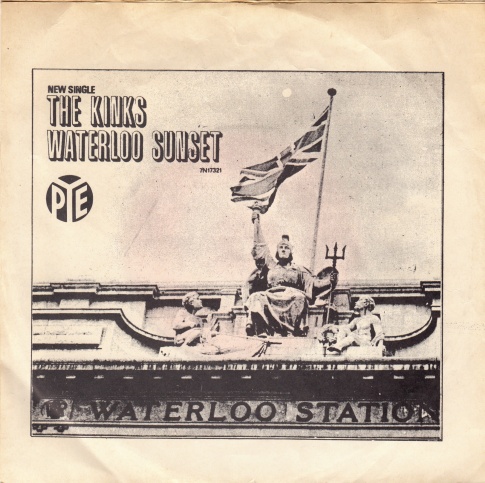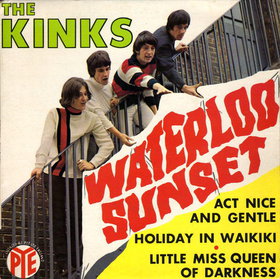| Notes and Quotes: "Waterloo Sunset" |
| Many of Ray Davies' songs demonstrate his preference for related melodies that he links together sequentially. In "Waterloo Sunset," Davies creates a compound melodic form by combining an aaba verse followed by an asymetrical chorus. A number of performances we have studied this semester have an aaba (verse, verse, chorus, verse) form or a verse-chorus form. This song combines those two approaches to organizing musical material. |
| Perhaps as importantly, Davies paints another compelling tableau of life in London, particularly the area around Waterloo Station near the Thames. |
| Ray Davies: The story goes this came to me in a dream. Maybe it came to me in a hangover. I remember it going through my head as I woke up. The best things just come out of the blue. Waterloo Sunset was one. In my head it was for a singer like Frank Sinatra. A proper singer. I had a beautiful notion that it was going to be Liverpool Sunset. But it felt a bit cynical. Why would Frank Sinatra sing a song about Liverpool? So it changed. |
| The place, Waterloo, is key to me. When I was about 14 I had to have an operation. My lungs collapsed and all sorts of things went wrong with me, so I was put in St Thomas’ Hospital [overlooking the Thames]. A really bad time, but they took me out while I recovered and I remember looking at the river, the really thick water. That image stayed with me. Then when I was a student, I used to get the Tube down to Waterloo and meet my first girlfriend and walk along the river. So all those connections slowly came together. |
| The choice of lovers’ names, Terry and Julie. It’s partly a scanning issue, the way they sound. But if a feature film had been made at that time, Terence Stamp and Julie Christie would’ve been in it. Just recently I got a really nice message from Julie Christie. She came to London to see The Kinks musical Sunny Afternoon and I didn’t know she was going. Afterwards she sent me this lovely card – ‘We were destined never to meet, again…’ |
Q Magazine. “Face to Face with Ray Davies.” Q Magazine (29 November 2016): https://www.pressreader.com/uk/q-uk/20161129/283519385486701 |
| Ray Davies (2006): It was going to be called Liverpool Sunset... At that stage it was about the death of Merseybeat, though subconsciously, it was probably inspired by my admiration for the Beatles... I sensed that the Beatles weren't going to be around for long. When they moved to London, and ended up in Knightsbridge or wherever, I was still in Muswell Hill. I was loyal to my origins. Maybe I felt when they left [Liverpool] it was all over for Merseybeat. (313) |
| Terry and Julie are to do with the aspirations of my sisters' generation. who grew up during World War Two and missed out on the Sixties. Sometimes when you're writing and you're on good form, you get into the frame of mind where you think, "I can relate to any of these things." It's something I learned through art school — let the ideas flow. (314) |
| I imagined it..., but when I imagine things, I imagine the truth. It's so much better when it comes from how you imagine it thatn how you report it... It doesn't mean anything. But when you hear the record, it means a lot. All the colours are there. I had to go into the studio and produce that record because that made up for me not being a painter. When I did the mix, I came down to Waterloo Bridge, to see if it worked. It was my substitute for not being able to pain it. (314) |
| "Waterloo Sunset" is an / accumulation of several memories... It's a remembrance of the time I went with my first girlfriend, who became my wife, to the Embankment and thought aobut our future and just absorbed the atmosphere. The other time was when I was in hospital at St. Thomas' after quite a serious injury when I was a child and the view of the river and the romantic attachment I have to it. And then, as a student, I did a few months at Croydon Art School while I was waiting to go to another school and I used to get the Tube down to Charing Cross and change there. I saw a lot of the station. So it's a culmination of all my desires and hopes — it's a song about people going to a better world, but somehow I stayed where I was and became the observer in the song rather than the person who is proactive... I did not cross the river. They did and had a good life apparently. It's the totatlity of it. It's the ideas and sounds mixed together. It's a bit like an audio picture rather than a "sonic sound" that triggers you. It allows people to interpret their own dreams within the song. And most people like to daydream. Sometimes, peoples lives are so complex and difficult, they're so busy dealing with the relities of the world, they like being taken off for a week somewhere, an emotional trip with music... lots of people make those records. (314-315) |
| Johnny Rogan. Ray Davies: A Complicated Life. London: Bodley Head, 2015. |
| Ray Davies. A song called 'Waterloo Sunset,' for example, it was a fantasy about my sister going off with her boyfriend to a new world and they were going to emigrate and go to another country. A lot of people have their own images of what that song's really about, and I like the song, but I'm amazed at the affection, particularly in England, that song is held in. [Steve Baltin (27 March 2008). "The Kinks' Ray Davies Serves Up Songs at the 'Working Man's Cafe'"] |
| Davies: Liverpool is my favourite city, and the song was originally called Liverpool Sunset... I was inspired by Merseybeat. I'd fallen in love with Liverpool by that point. On every tour, that was the best reception. We played The Cavern, all those old places, and I couldn't get enough of it... I had a load of mates in bands up there, and that sound – not The Beatles but Merseybeat – that was unbelievable. It used to inspire me every time... So I wrote Liverpool Sunset. Later it got changed to Waterloo Sunset, but there's still that play on words with Waterloo... |
| "How a lonely Londoner created one of the great Sixties songs". The Independent. 26 August 2011. Retrieved 2014-06-14. |
 |
 |
| Schedule |
| 4 December, 2017 |